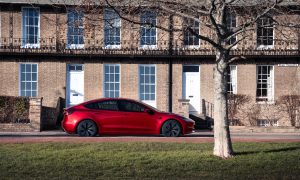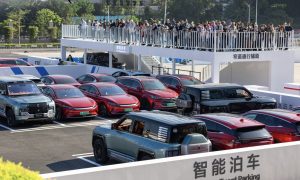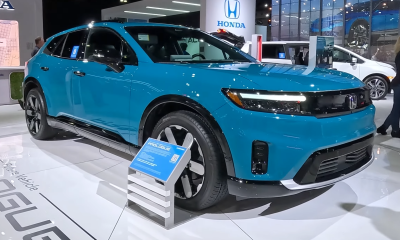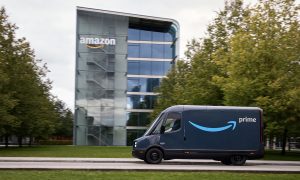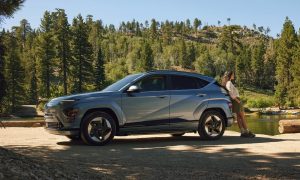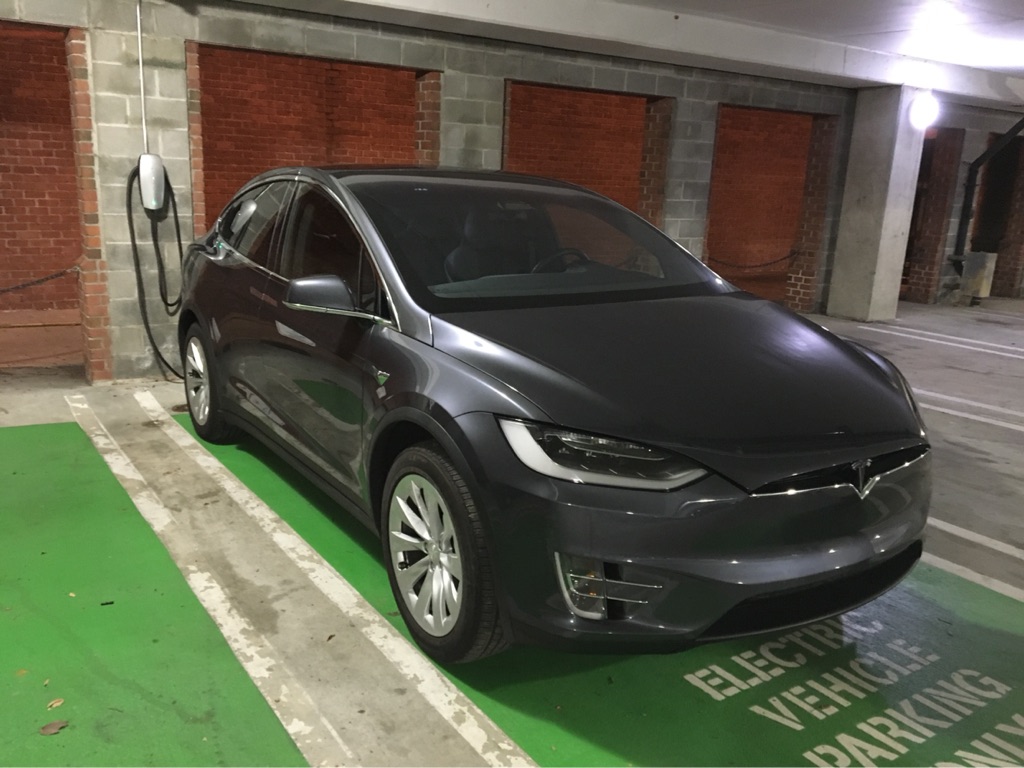

News
EV adoption spurs updated guidance on parking structure design
As electric vehicles (EVs) become increasingly common on roads around the world, many infrastructural changes will be needed to accommodate them. One example includes the design of parking garages, which some say will require updated fire safety protocols and additional modifications to accommodate the heavy weight of EVs.
The United Kingdom’s Institution of Structural Engineers released a new design guidance for parking garages earlier this year, pointing out a broad range of topics related to the structures, from EV weight, charging access and reduced noise levels to fire safety considerations (via CNBC). The guidance includes suggestions for the design of garages that are multi-story, underground or simply located inside offices or residential buildings.
Perhaps the most pressing topic included in the guidance for parking garages — called multi-story car parks in the U.K. — is the battery hardware used in EVs, which makes them much heavier than internal combustion engine (ICE) vehicles. With increased range models and a wider span of vehicle classes, EV weights will likely continue getting heavier in the future.
“This extra load and the changing fire safety requirements are all considerations not just for new car parks, but for existing structures too,” the institution writes in the report.
According to the group, average vehicle weights have increased from 1.5 metric tons (3,307 pounds) in 1974 to almost 2 metric tons (4,409 pounds) this year. As one example, Tesla’s forthcoming Cybertruck is a stainless steel behemoth, expected to weigh somewhere between 5,000 and 8,000 pounds (2.3 to 3.6 metric tons).
Institution fellow and co-author of the guidance Chris Whapples also notes that some newer EVs are well over 3 metric tons (6,614 pounds).
“The thing to bear in mind is that the ones that cause the damage, if you like, are the heavy vehicles — not the vehicles that are heavier than they were 40 years ago but still within the capacity of the design for car parks,” Whapples explained in an interview with CNBC. “We’re seeing increasing numbers now of SUVs, large executive cars — both fossil-fueled and battery ones — and pickup trucks, which are immensely heavy.”
Whapples details a handful of potential solutions for heavy vehicles, primarily including the need to retrofit older garages with increased structural support, either in specific spots that are determined to be weaker or in their entirety. He also notes that heavy vehicles could stay on ground floors to park, and garages could even screen the weights of cars as they enter.
“If one pickup is significantly overloaded and that car park is weak, that’s a potential disaster waiting to happen,” Whapples added. “We said, as an industry, we must actually check our car parks out and make sure that that’s not going to happen. Because what we want is the public to maintain confidence in our car parks and structural engineers.”
Another top concern detailed in the guidance was improving fire safety protocols in parking garages. Whapples notes that fire risks aren’t exclusive to EVs, adding that gasoline cars can also start fires and make situations more complicated. While EV fires aren’t considered more common than ICE vehicle fires, they can be especially tough to put out, he explains.
“To actually extinguish an EV fire is very, very difficult — particularly if the battery is on fire, because you’ve got so much energy that’s locked in,” Whapples said.
As for potential solutions, Whapples says that sprinkler systems could be an important way to mitigate fire spread, especially in underground car parks.
“Although the sprinkler system will not put out the car fire, it will reduce the rate of spread within the car park, so it’s constantly … ‘quenching’ the car next to the one that’s on fire, and stopping that one from catching fire,” Whapples explains.
All of these and more points will need to be considered ahead of mass EV adoption, both for existing garages and newly built construction. The International Energy Agency (IEA) expects EVs, buses, vans and heavy trucks to reach as many as 145 million units globally by 2030, though government ramp-up efforts could boost that number even more. In 2022, 10 million EVs were sold, including plug-in hybrids and battery-electric vehicles.
The discussions come ahead of Tesla’s initial release of the Cybertruck, which has been widely discussed for its large size, among other details. If many EVs are physically larger than ICE vehicles in the future, it could also require garages to be built with similarly larger parking spaces. Tesla has rolled out some wider and longer parking spaces at its Supercharger stations for the Cybertruck, a move that may be necessary for all parking structures down the road.
What are your thoughts? Let me know at zach@teslarati.com, find me on X at @zacharyvisconti, or send your tips to us at tips@teslarati.com.
Elon Musk
Why Tesla’s Q3 could be one of its biggest quarters in history
Tesla could stand to benefit from the removal of the $7,500 EV tax credit at the end of Q3.

Tesla has gotten off to a slow start in 2025, as the first half of the year has not been one to remember from a delivery perspective.
However, Q3 could end up being one of the best the company has had in history, with the United States potentially being a major contributor to what might reverse a slow start to the year.
Earlier today, the United States’ House of Representatives officially passed President Trump’s “Big Beautiful Bill,” after it made its way through the Senate earlier this week. The bill will head to President Trump, as he looks to sign it before his July 4 deadline.
The Bill will effectively bring closure to the $7,500 EV tax credit, which will end on September 30, 2025. This means, over the next three months in the United States, those who are looking to buy an EV will have their last chance to take advantage of the credit. EVs will then be, for most people, $7,500 more expensive, in essence.
The tax credit is available to any single filer who makes under $150,000 per year, $225,000 a year to a head of household, and $300,000 to couples filing jointly.
Ending the tax credit was expected with the Trump administration, as his policies have leaned significantly toward reliance on fossil fuels, ending what he calls an “EV mandate.” He has used this phrase several times in disagreements with Tesla CEO Elon Musk.
Nevertheless, those who have been on the fence about buying a Tesla, or any EV, for that matter, will have some decisions to make in the next three months. While all companies will stand to benefit from this time crunch, Tesla could be the true winner because of its sheer volume.
If things are done correctly, meaning if Tesla can also offer incentives like 0% APR, special pricing on leasing or financing, or other advantages (like free Red, White, and Blue for a short period of time in celebration of Independence Day), it could see some real volume in sales this quarter.
You can now buy a Tesla in Red, White, and Blue for free until July 14 https://t.co/iAwhaRFOH0
— TESLARATI (@Teslarati) July 3, 2025
Tesla is just a shade under 721,000 deliveries for the year, so it’s on pace for roughly 1.4 million for 2025. This would be a decrease from the 1.8 million cars it delivered in each of the last two years. Traditionally, the second half of the year has produced Tesla’s strongest quarters. Its top three quarters in terms of deliveries are Q4 2024 with 495,570 vehicles, Q4 2023 with 484,507 vehicles, and Q3 2024 with 462,890 vehicles.
Elon Musk
Tesla Full Self-Driving testing continues European expansion: here’s where
Tesla has launched Full Self-Driving testing in a fifth European country ahead of its launch.

Tesla Full Self-Driving is being tested in several countries across Europe as the company prepares to launch its driver assistance suite on the continent.
The company is still working through the regulatory hurdles with the European Union. They are plentiful and difficult to navigate, but Tesla is still making progress as its testing of FSD continues to expand.
Today, it officially began testing in a new country, as more regions open their doors to Tesla. Many owners and potential customers in Europe are awaiting its launch.
On Thursday, Tesla officially confirmed that Full Self-Driving testing is underway in Spain, as the company shared an extensive video of a trip through the streets of Madrid:
Como pez en el agua …
FSD Supervised testing in Madrid, Spain
Pending regulatory approval pic.twitter.com/txTgoWseuA
— Tesla Europe & Middle East (@teslaeurope) July 3, 2025
The launch of Full Self-Driving testing in Spain marks the fifth country in which Tesla has started assessing the suite’s performance in the European market.
Across the past several months, Tesla has been expanding the scope of countries where Full Self-Driving is being tested. It has already made it to Italy, France, the Netherlands, and Germany previously.
Tesla has already filed applications to have Full Self-Driving (Supervised) launched across the European Union, but CEO Elon Musk has indicated that this particular step has been the delay in the official launch of the suite thus far.
In mid-June, Musk revealed the frustrations Tesla has felt during its efforts to launch its Full Self-Driving (Supervised) suite in Europe, stating that the holdup can be attributed to authorities in various countries, as well as the EU as a whole:
Tesla Full Self-Driving’s European launch frustrations revealed by Elon Musk
“Waiting for Dutch authorities and then the EU to approve. Very frustrating and hurts the safety of people in Europe, as driving with advanced Autopilot on results in four times fewer injuries! Please ask your governing authorities to accelerate making Tesla safer in Europe.”
Waiting for Dutch authorities and then the EU to approve.
Very frustrating and hurts the safety of people in Europe, as driving with advanced Autopilot on results in four times fewer injuries!
Please ask your governing authorities to accelerate making Tesla safer in Europe. https://t.co/QIYCXhhaQp
— Elon Musk (@elonmusk) June 11, 2025
Tesla said last year that it planned to launch Full Self-Driving in Europe in 2025.
Elon Musk
xAI’s Memphis data center receives air permit despite community criticism
xAI welcomed the development in a post on its official xAI Memphis account on X.

Elon Musk’s artificial intelligence startup xAI has secured an air permit from Memphis health officials for its data center project, despite critics’ opposition and pending legal action. The Shelby County Health Department approved the permit this week, allowing xAI to operate 15 mobile gas turbines at its facility.
Air permit granted
The air permit comes after months of protests from Memphis residents and environmental justice advocates, who alleged that xAI violated the Clean Air Act by operating gas turbines without prior approval, as per a report from WIRED.
The Southern Environmental Law Center (SELC) and the NAACP has claimed that xAI installed dozens of gas turbines at its new data campus without acquiring the mandatory Prevention of Significant Deterioration (PSD) permit required for large-scale emission sources.
Local officials previously stated the turbines were considered “temporary” and thus not subject to stricter permitting. xAI applied for an air permit in January 2025, and in June, Memphis Mayor Paul Young acknowledged that the company was operating 21 turbines. SELC, however, has claimed that aerial footage shows the number may be as high as 35.
Critics are not giving up
Civil rights groups have stated that they intend to move forward with legal action. “xAI’s decision to install and operate dozens of polluting gas turbines without any permits or public oversight is a clear violation of the Clean Air Act,” said Patrick Anderson, senior attorney at SELC.
“Over the last year, these turbines have pumped out pollution that threatens the health of Memphis families. This notice paves the way for a lawsuit that can hold xAI accountable for its unlawful refusal to get permits for its gas turbines,” he added.
Sharon Wilson, a certified optical gas imaging thermographer, also described the emissions cloud in Memphis as notable. “I expected to see the typical power plant type of pollution that I see. What I saw was way worse than what I expected,” she said.
-

 Elon Musk3 days ago
Elon Musk3 days agoTesla investors will be shocked by Jim Cramer’s latest assessment
-

 News1 week ago
News1 week agoTesla Robotaxi’s biggest challenge seems to be this one thing
-

 News2 weeks ago
News2 weeks agoTexas lawmakers urge Tesla to delay Austin robotaxi launch to September
-

 Elon Musk2 weeks ago
Elon Musk2 weeks agoFirst Look at Tesla’s Robotaxi App: features, design, and more
-

 Elon Musk2 weeks ago
Elon Musk2 weeks agoxAI’s Grok 3 partners with Oracle Cloud for corporate AI innovation
-

 News2 weeks ago
News2 weeks agoSpaceX and Elon Musk share insights on Starship Ship 36’s RUD
-

 News2 weeks ago
News2 weeks agoWatch Tesla’s first driverless public Robotaxi rides in Texas
-

 News2 weeks ago
News2 weeks agoTesla has started rolling out initial round of Robotaxi invites


